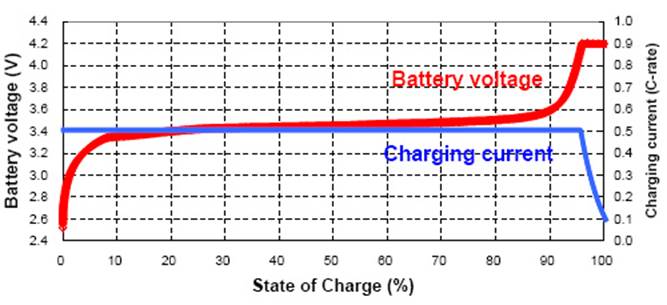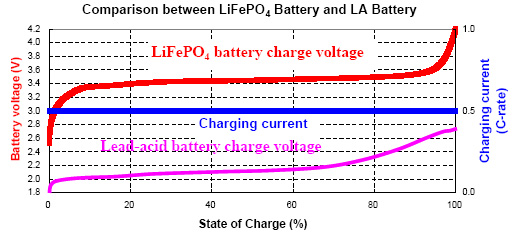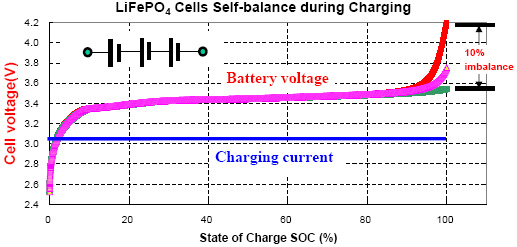seperempat atau hanya satu lampu yang hidup, dinamo akan hidup mati, pengendara akan merasakan sentakan yang hidup mati pada penggerak roda.
Walaupun dalam buku panduan, battery hanya dapat bertahan 1 jam atau 55 kilometers, tetapi pada hasil test yang telah kami lakukan battery dapat bertahan selama dua jam lebih.
Battery yang baik akan menyimpan lebih lama dan menghidupkan dinamo lebih kuat.
Data Perbandingan Battery yang diambil dari Golden Motor
C-LiFePO4 | LiCoO2 | LiMn2O4 | Li(NiCo)O2 | |
SAFETY AND ENVIRONMENTAL CONCERN | Excellent, Best among all existing batteries | Not stable every dangerous | Acceptable | Not stable very dangerous |
CYCLE LIFE | Excellent Best among all the listed groups | Acceptable | Unacceptable | Acceptable |
POWER WEIGHT DENSITY | Acceptable | Good | Acceptable | Best |
LONG TERM COST | Excellent Most economic | High | Acceptable | High |
WORKING TEMP. | Excellent -45C�C70C | Decayed beyond -20C �C 55C | Decayed extremely fast over 50C | Decayed extremely fast over -20C �C 55C |
REMARK | 1. Although, Lead Acid battery is lower in cost and safety acceptable; however, with extremely toxic, worse for the environmental concern, short cycle life, heavy in weight, therefore, we don't put it as a group for comparison. 2. Nickel Hydride battery has a characteristic of low Power Weight Density, decayed faster under the high temperature, worse in memory effect, not suitable for high output usage. 3. The C-coated Lithium Iron Phosphate Battery has been proven as the most environmental friendly battery. It is the safest and most suitable for high output usage. It is also the best for storage battery usage. | |||
Innovation in Li-ion Battery
LiFePO4 Power Battery: Faster charging and safer performance
LiFePO4 Power Battery: Faster charging and safer performance
It is clear that the small capacity Li-ion (polymer)
- Fast charging: During charging process, a conventional Li-ion Battery containing lithium cobalt oxide (LiCoO2) needs two steps to be fully charged: step 1 is using constant current (CC) to get 60% State of Charge (SOC); step 2 takes place when charge voltage reaches 4.2V, upper limit of charging voltage, turning from CC to constant voltage (CV) while the charging current is taping down. The step 1 (60%SOC) needs two hours and the step 2 (40%SOC) needs another two hours. LiFePO4 battery can be charged by only one step of CC to reach 95%SOC or be charged by CC+CV to get 100%SOC. The total charging time will be two hours.

2. Large overcharge tolerance and safer performance
A LiCoO2 battery has a very narrow overcharge tolerance, about 0.1V over 4.2V of charging voltage plateau and upper limit of charge voltage. Continuous charging over 4.3V would either damage the battery performance, such as cycle life, or result in firing and explosion. A LiFePO4 battery has a much wider overcharge tolerance of about 0.7V from its charging voltage plateau 3.4V. Exothermic heat of chemical reaction with electrolyte measured by DSC after overcharge is only 90J/g for LiFePO4 verse 1600J/g for LiCoO2 . The more is the exothermic heat, the larger energy heating up the battery in its abusive condition, the more chance toward firing and explosion. A LiFePO4 battery would be overcharged upto 30V without portection circuit board. It is suitable for large capacity and high power applications. From viewpoint of large overcharge tolerance and safety performance, a LiFePO4 battery is similar to lead-acid battery.

3. Self balance
Alike lead-acid battery, a number of LiFePO4 cells in a battery pack in series connection would balance each other during charging process, due to large overcharge tolerance. This self balance character can allow 10% difference between cells for both voltage and capacity inconsistency.

Alike lead-acid battery, a number of LiFePO4 cells in a battery pack in series connection would balance each other during charging process, due to large overcharge tolerance. This self balance character can allow 10% difference between cells for both voltage and capacity inconsistency.

4. Simplifying battery management system (BMS) and battery charger
Large overcharge tolerance and self-balance character of LiFePO4 battery would simplify battery protection and balance circuit boards, lowering their cost. One step charging process would allow to use simpler conventional power supplier to charge LiFePO4 battery instead to use a expensive professional Li-ion battery charger.
5. Longer cycle life
In comparison with LiCoO2 battery which has a cycle life of 400 cycles, LiFePO4 battery extends its cycle life up to 2000 cycles.
6. High temperature performance
It is detrimental to have a LiCoO2 battery working at elevated temperature, such as 60C.. However, a LiFePO4 battery runs better at elevated temperature, offering 10% more capacity, due to higher lithium ionic conductivity.
Large overcharge tolerance and self-balance character of LiFePO4 battery would simplify battery protection and balance circuit boards, lowering their cost. One step charging process would allow to use simpler conventional power supplier to charge LiFePO4 battery instead to use a expensive professional Li-ion battery charger.
5. Longer cycle life
In comparison with LiCoO2 battery which has a cycle life of 400 cycles, LiFePO4 battery extends its cycle life up to 2000 cycles.
6. High temperature performance
It is detrimental to have a LiCoO2 battery working at elevated temperature, such as 60C.. However, a LiFePO4 battery runs better at elevated temperature, offering 10% more capacity, due to higher lithium ionic conductivity.
No comments:
Post a Comment